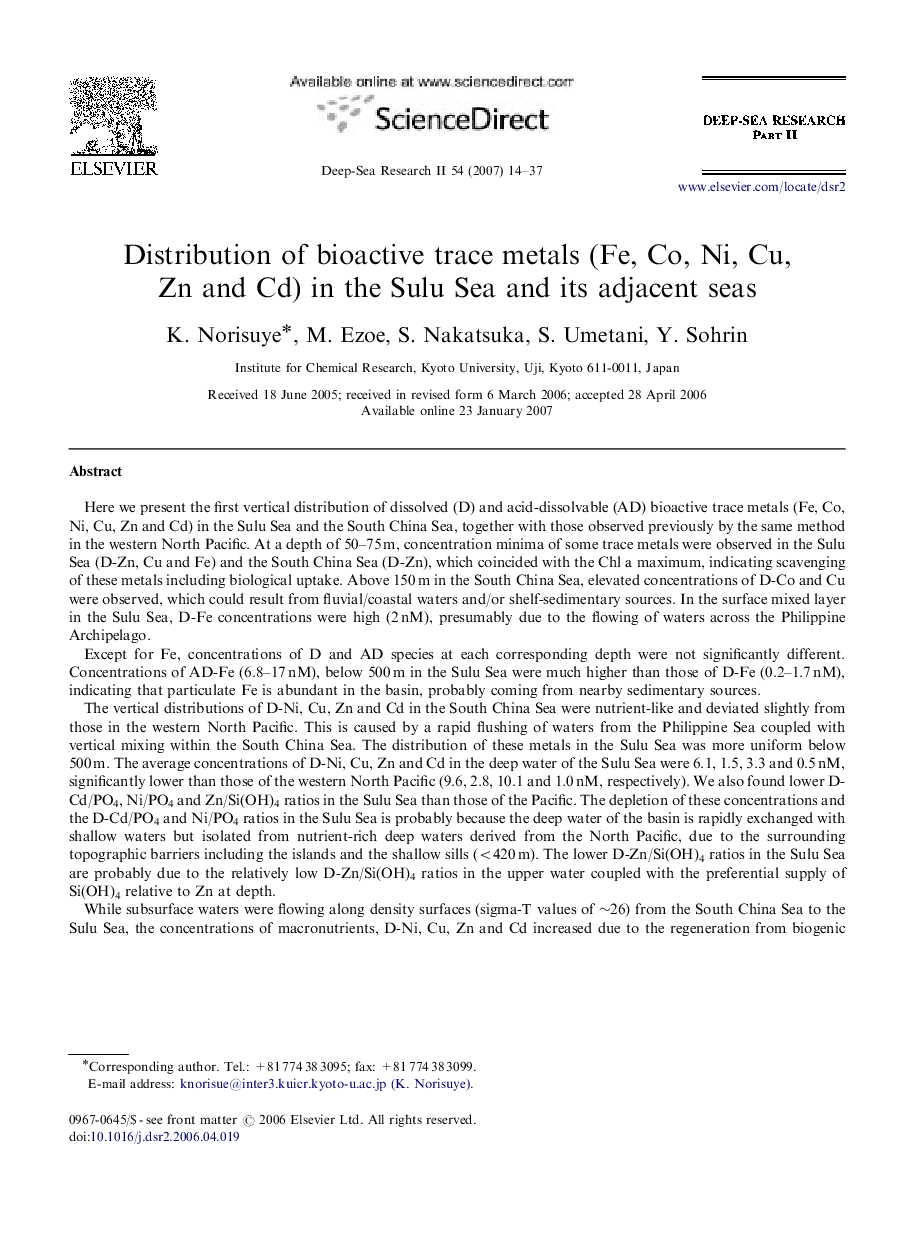| Article ID | Journal | Published Year | Pages | File Type |
|---|---|---|---|---|
| 4537335 | Deep Sea Research Part II: Topical Studies in Oceanography | 2007 | 24 Pages |
Here we present the first vertical distribution of dissolved (D) and acid-dissolvable (AD) bioactive trace metals (Fe, Co, Ni, Cu, Zn and Cd) in the Sulu Sea and the South China Sea, together with those observed previously by the same method in the western North Pacific. At a depth of 50–75 m, concentration minima of some trace metals were observed in the Sulu Sea (D-Zn, Cu and Fe) and the South China Sea (D-Zn), which coincided with the Chl a maximum, indicating scavenging of these metals including biological uptake. Above 150 m in the South China Sea, elevated concentrations of D-Co and Cu were observed, which could result from fluvial/coastal waters and/or shelf-sedimentary sources. In the surface mixed layer in the Sulu Sea, D-Fe concentrations were high (2 nM), presumably due to the flowing of waters across the Philippine Archipelago.Except for Fe, concentrations of D and AD species at each corresponding depth were not significantly different. Concentrations of AD-Fe (6.8–17 nM), below 500 m in the Sulu Sea were much higher than those of D-Fe (0.2–1.7 nM), indicating that particulate Fe is abundant in the basin, probably coming from nearby sedimentary sources.The vertical distributions of D-Ni, Cu, Zn and Cd in the South China Sea were nutrient-like and deviated slightly from those in the western North Pacific. This is caused by a rapid flushing of waters from the Philippine Sea coupled with vertical mixing within the South China Sea. The distribution of these metals in the Sulu Sea was more uniform below 500 m. The average concentrations of D-Ni, Cu, Zn and Cd in the deep water of the Sulu Sea were 6.1, 1.5, 3.3 and 0.5 nM, significantly lower than those of the western North Pacific (9.6, 2.8, 10.1 and 1.0 nM, respectively). We also found lower D-Cd/PO4, Ni/PO4 and Zn/Si(OH)4 ratios in the Sulu Sea than those of the Pacific. The depletion of these concentrations and the D-Cd/PO4 and Ni/PO4 ratios in the Sulu Sea is probably because the deep water of the basin is rapidly exchanged with shallow waters but isolated from nutrient-rich deep waters derived from the North Pacific, due to the surrounding topographic barriers including the islands and the shallow sills (<420 m). The lower D-Zn/Si(OH)4 ratios in the Sulu Sea are probably due to the relatively low D-Zn/Si(OH)4 ratios in the upper water coupled with the preferential supply of Si(OH)4 relative to Zn at depth.While subsurface waters were flowing along density surfaces (sigma-T values of ∼26) from the South China Sea to the Sulu Sea, the concentrations of macronutrients, D-Ni, Cu, Zn and Cd increased due to the regeneration from biogenic particles. The increases in the concentrations of bioactive elements relative to that of PO4 were N : P : Si : Ni : Cu : Zn : Cd=15 : 1 : 40 : 2.4×10−3 : 0.6×10−3 : 2.7×10−3 : 0.03×10−3 in a molar unit.
